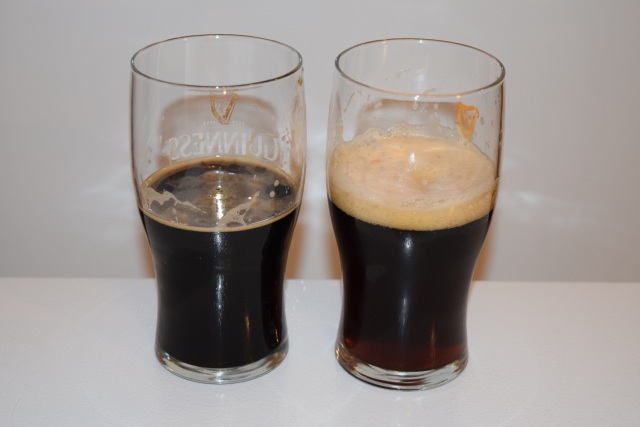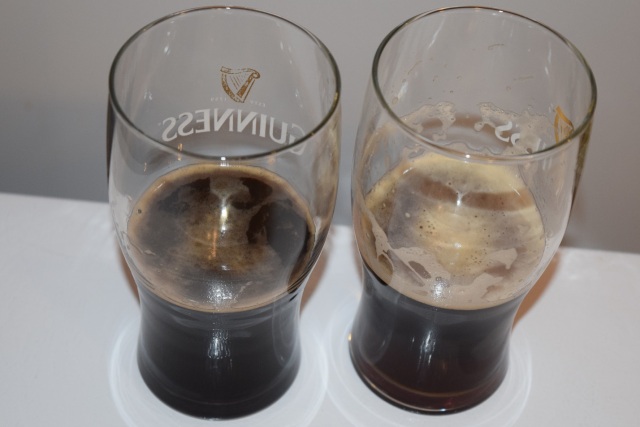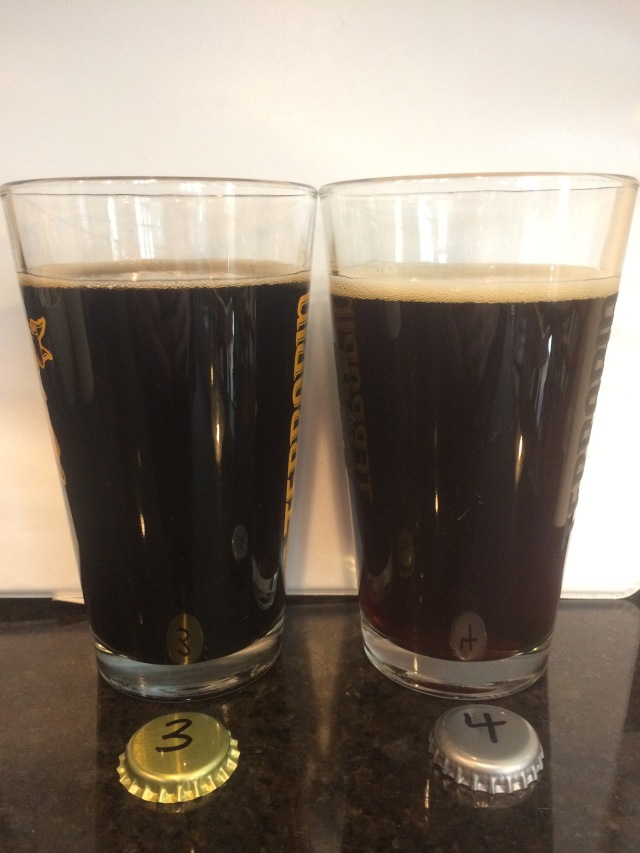This post is one in a series following six brewers collaborating to each make a small adjustment to a single recipe in order to improve it, then pass it along to the next brewer. We hope to learn more about the art of recipe creation as we see how other brewers approach the same recipe. The rest of the comparison tastings for this series can be found here.
The recipes for the beers being compared below are as follows:
| Iteration 3 | Iteration 4 | |
| Base Malt | 80% 2-row | 72.5% 2-row |
| Specialty Malt 1 | 5% Victory | 10.8% Victory |
| Specialty Malt 2 | 10% Roasted Barley | 4.4% Roasted Barley |
| Specialty Malt 3 | 5 % Chocolate Malt | 4.4% Chocolate Malt |
| Specialty Malt 4 | None | 7.8% Flaked Barley |
| 60 min. hop | Nugget: 47.7 IBUs | Nugget: 41.2 IBUs |
| 5 min. hop | Willamette: 2.9 IBUs | Willamette: 3 IBUs |
| Yeast | US-05 | US-05 |
| OG | 1.045 | 1.065 |
| FG | 1.005 | 10.20 |
| ABV | 5.25% | 5.9% |
Taster: M. Willis
Iteration 3 has an attractive medium-brown color to the head. The head is somewhat short-lived but leaves nice lacing on the glass. The head fades to cover about half the beer. Iteration 4 had a longer lasting, lighter brown, THICK head. The pronounced cap of head sits like a blanket on this beer and leaves beautiful lacing in this iteration. Iteration 3 is inky black in color, while Iteration 4 is lighter, but still a medium-dark brown color.

Left: Iteration 3; Right: Iteration 4
It’s been 40 days since I first sampled Iteration 3. Time has been good to it as it has pleasant coffee and dark cherry notes in the aroma. The chocolate noticed during the original tasting has fallen to the wayside though. Speaking of changes since that first sample, what happened to the umami/soy sauce? It peaks its head out once warm, but it’s nowhere near as sharp as before. Iteration 4 sees chocolate rejoin the coffee and dark cherry—at least while young. Will it fade like Iteration 3? I’m mostly hoping the dark cherry notes further increase with time. I’ll be putting some of these away to see.

Left: Iteration 3; Right: Iteration 4
Flavor follows the nose in both beers. The coffee and dark cherry stand out in both Iteration 3 and 4. The bittersweet chocolate in 3 has diminished since the first tasting and it is only just there in 4 as well. Again the hops are subdued or too complimentary to be noticed. There’s a clear malt sweetness in Iteration 4 that’s only noticeable in a warm Iteration 3. Like most stouts, both of these beers turn the volume up in malt flavor and sweetness as they warm. Iteration 3 has that umami/soy sauce flavor once quite warm. It no longer lingers on, nor is it present when cold.
Mouthfeel on Iteration 3 hasn’t changed much since the original tasting: it’s light bodied. Time didn’t fix that, but the black tea astringency has decreased a bit. Iteration 4 is creamy with all that flaked barley. That stickiness that laces the glass and blankets the beer also coats your tongue.

Left: Iteration 3; Right: Iteration 4
The biggest differences to me were the mouthfeel and color of the beers. I do like the improvement from the flaked barley. I am a proponent of flaked grains and was happy to see it made such an impact. Beersmith warned me the color would be out of range for a stout, but I pushed forward wanting to dial the roast grain flavor way down. I think the only thing lost from the previous iteration that made a strong impact on the overall quality of the recipe was the color. When side by side, Iteration 3 is more visually appealing. Some improvement was made, but there is definitely room for more. Balance is the most important component of a recipe. I wish you could just buy it.
Taster: C. McKenzie
Iteration 3 was black in appearance, with a moderate, tan head that had minimal retention. Iteration 4 was dark brown in color with a definite red tint to it when held up to the light. This beer poured with a moderate, white head that had good retention.

Iteration 3 smelled roasty and had notes of coffee and dark chocolate in the nose. Iteration 4 had less aroma overall, but definitely began to open up as it warmed. This beer had hints of a lightly roasted coffee (though without that acidic scent particular to many lightly roasted coffees), roasted notes, toast, and perhaps a touch of cinnamon—perhaps.
The flavor of Iteration 3 was one of dark chocolate, toast, and coffee that has sat on the burner for several hours. Iteration 4 had a hint of coffee, semisweet chocolate, and a slight roasted flavor. The flavors of this beer meld well together and come together in such a way that they provide a very smooth beer that is not at all biting as some stouts can be.
